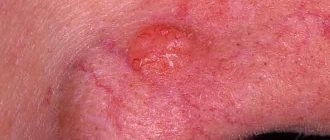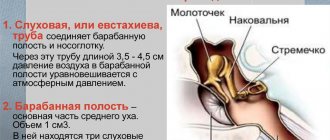Causes of the disease
The main causes of this serious disease are untreated diseases leading to complications. Ear cancer can occur in adulthood due to an illness that was not treated in childhood. New growths in the ear appear due to radiation exposure, heredity (if close relatives have been diagnosed with ear diseases). Symptoms of a tumor in a person’s ear may not appear for a long time.
Experts identify several causes of ear cancer:
- ear diseases that have developed into a chronic form;
- complications from laryngitis;
- ear eczema;
- otitis;
- polyps in the ENT organs;
- precancerous diseases.
Attention! According to statistics, out of 100 cancers, 2 occur in the ENT organs.
Malignant formations in the human ear: what are they called?
Growths have primary and secondary origin. The former develop from ear tissue, and the secondary arise as a result of metastasis processes from other organs.
There are 4 main types of malignant tumors:
- spinocellular epithelioma - looks like a wart, grows very quickly in depth and width. It appears most often in mature men on the lobe or at the beginning of the ear canal. Metastases spread to the salivary glands, the area of the skull and the middle ear;
- basal cell carcinoma – characterized by very slow growth, metastases in the later stages of development. It has the shape of a plaque or nodule with a pinkish tint. Outwardly it resembles an ulcer, which tends to bleed, crust over, and then peel off;
- sarcoma - appears mainly in children under 10 years of age, but is extremely rare. In an adult, its development depends on its location. External ones grow and develop slowly, internal ones - quickly, with metastases and destruction of the eardrum;
- melanoma - arises from pigment cells of the skin, grows rapidly, metastasizes through the blood and lymph to any internal organ, and is practically untreatable.
Main symptoms:
- strong, sometimes unbearable painful sensations that can radiate to the head;
- the pain is burning, fiery in nature, as if you had received a burn, at first it is periodic in nature, gradually intensifying, especially at night.
- mucus or pus may come out of the ear, as in acute otitis media;
- Patients experience tinnitus and hearing loss, which may disappear completely.
Varieties
Experts classify pathology depending on several parameters. Like cancer of any other organ, ear tumors can be malignant or benign.
The first type includes:
- Melanomas. The disease progresses due to the proliferation of moles or cells. A special feature is the spread of pathogenic cells deep into the tissue. Statistics show that the disease is more common in women than in men.
- Sarcomas. A rare form of the disease, characterized by the slow development of a tumor in the ear, and most often patients find out about it in the later stages. Externally, it is a small round formation of a white-yellow hue.
- Cancer of the external auditory canal (carcinoma). The tumor develops rarely, and pathological processes in the ear are asymptomatic. The tumor may spread to nearby tissues. The spread of metastases to the temple bones, their proliferation and rapid progression is dangerous.
- Basaliomas. The disease progresses slowly, forming ulcers. It occurs more often in older men. Externally, the formations look like ulcers.
- Squamous cell carcinoma. The most common type of cancer. Most cases affect older men. It takes a long time to develop and without the necessary treatment spreads to nearby tissues.
We recommend reading Colon cancer - causes, diagnosis, treatment
Benign forms make up a large group:
- Fibroids. They appear on the earlobe, in the place where the earring is pierced. The spread of the tumor should not be ruled out. The sizes vary and can reach the size of a nut.
- Nevi. They look like small moles that appear due to the excessive development of melanocytes.
- Adenomas. Neoplasms of nodular type. Formed from glandular epithelial tissues.
- Papillomas. Appear on the shell and in the outer ear. They are characterized by slow development and small size.
- Lipomas. They are formed from subcutaneous tissues and often recur.
- Hemangiomas. One of the most common types of ear tumors with long-term development. Spreads to other organs, causing bleeding and complications.
In addition to this classification, human ear oncology is also divided according to the degree of development of the disease (primary and secondary). In the primary stage, the disease is observed only in the auricle, while the secondary stage is characterized by rapid growth and spread of metastases to other organs.
Doctors divide the types of cancer depending on its structure:
- ulcerative;
- solitary-vegetative;
- ulcerative-infiltrative.
According to localization in the area of the ear canal, they are distinguished:
- Oncology of the concha. A common disease, more than 80% of cases are diagnosed with ear cancer.
- External ear disease. Pathology is diagnosed in 15% of cases.
- Middle ear cancer. A rare disease diagnosed in 4% of cases.
And, of course, the disease is differentiated by the degree of progression. Ear cancer has four stages:
- Stage 1 is characterized by the formation of an ulcer on the skin of no more than 2-5 mm.
- Stage 2 - the tumor spreads to the tissues of the ear, gradually destroying it.
- Stage 3 is manifested by adenopathy.
- Stage 4 pathology is characterized by enlargement of the lymph nodes located in the neck.
Causes and course of the disease
Squamous cell carcinoma of the outer ear at the initial stage of development is very similar to basal cell carcinoma, a type of skin cancer that develops from the basal layer of the epithelium, but in comparison with it, it grows much faster. The tumor very often metastasizes to regional lymph nodes (behind the ear, parotid and deep cervical) nodes.
Neoplasms that arise on the lower wall pass through the Santorini fissures to the parotid salivary gland and the bony part of the external auditory canal. Tumors of the bony part of the external auditory canal can quite easily penetrate the tympanic cavity.
Symptoms
The clinical picture of the disease depends on many factors. The danger for people with cancer is that the pathology remains latent for a long time and is difficult to detect at an early stage. If a harmless formation is detected, you should consult a specialist to rule out the development of cancer.
We recommend reading Squamous cell non-keratinizing, keratinizing cervical cancer - causes, symptoms, treatment
The middle and outer ear tumor is manifested by the following symptoms:
- frequent dizziness;
- shooting pain in the ear, radiating to the jaw area;
- discharge;
- itching and burning;
- enlarged lymph nodes;
- congestion in the ears;
- unpleasant smell.
If short-term symptoms of ear cancer appear, you should consult a doctor, since these are the first signs of cancer that can be combated. If you ignore the signs of an ear tumor, they will appear more frequently. If there is no oncology, the signs indicate serious illnesses, for example, otitis media. When the tumor progresses in the tympanic cavity, the following symptoms of ear cancer appear:
- noise in ears;
- hearing impairment;
- painful sensations.
Important! If you ignore these symptoms of a tumor in the ear, complete deafness will occur over time, and pathogenic cells will spread to nearby tissues. It is important to pay attention to the first signs of cancer development.
Symptoms of a middle ear tumor
A benign type of tumor in the middle ear is very rare. However, this type of inflammation has clearer symptoms. So, the patient experiences severe pressure and pain in the ear.
In addition, during the development and enlargement of the tumor, the functioning of the auditory ossicles is disrupted. As a result, the patient loses hearing acuity. In especially severe cases, the patient cannot make out high-pitched sounds at a short distance, and cannot hear whispers at all.
In addition, the following symptoms are identified:
- Noise and squeaking in the ears.
- Dizziness.
- Nausea and vomiting.
- Severe shooting pains.
- Pain in the ears and head.
- Balance imbalance.
- The appearance of various discharges from the ears.
In special situations, ear cancer in the middle part of the hearing organ is characterized by the rapid development of inflammation. As a consequence, with the rapid development of inflammation, perforation of the tympanic region occurs.
At this time, the patient experiences shooting pain in the ears. In especially severe cases, there is a violation of not only the tympanic area, but also the nearby walls. The pain becomes unbearable.
If the patient does not receive treatment at this level, the tumor grows into nearby tissues, vessels, and then into the inner area of the ear and onto the mucous part of the skull. Subsequently, cancer transitions from a benign type of inflammation to a malignant stage. In this case, in addition to pain, the patient experiences bleeding.
During the development of cancer in the ears, it can move to the area of the auditory tube, it can move into the nasopharynx. As a result, the patient develops pharyngeal cancer.
At the first symptoms, it is important to undergo a diagnosis of inflammation, which includes dermatoscopy and ultrasound.
An otolaryngologist, together with specialists in the skin and mucous membrane, conducts an examination of the patient.
In case of cancer formation in the outer ear, an otoscopy is performed.
If the inflammation is localized in the tympanic or middle part of the hearing organ, it is necessary to study and examine these areas using pharyngoscopy and microlaryngoscopy.
Following these procedures, it is necessary to conduct x-rays and CT scans of the skull.
To identify problems with the sensitivity of hearing acuity, it is necessary to conduct audiometry. This will help determine the type of hearing loss and the patient’s sensitivity to sounds. In addition, this type of examination will help determine whether the area of the inner ear is involved.
Diagnosis of ear tumor
Diagnosis of oncology is an important procedure for preventing the development of the disease. At the slightest suspicion of cancer, you should contact an oncologist or otolaryngologist.
The oncologist, after listening to the patient’s complaints, will send him for the following procedures:
- microotoscopy;
- biopsy;
- X-ray;
- probing;
- tomography
Treatment
If ear cancer is detected, it is important to begin early treatment to prevent complete hearing loss. The most effective treatment is surgery and supportive care.
Experts identify the following effective methods:
- Surgical method. The most common method of treatment involves the removal of the temporal bone, cartilage and the formation itself. If the tumor is small, then curettage is sufficient, but this method leads to the development of relapses.
- Radiation therapy. The most effective method is exposure to x-rays. This type is prescribed to patients with advanced disease when surgery is not possible. Treatment can reduce the intensity of symptoms.
- Chemotherapy. The method is basic, as it slows down the development of the disease.
- Radiotherapy. The method involves covering the hearing organ with a device that emits gamma rays.
- Cryodestruction. Used for diseases in the outer or middle ear. The essence of the method is simple: exposure to nitrogen, which causes the death of pathogenic cells.
- Cauterization. The healing method is similar to radiotherapy, the frequency of exposure is greater than that of the previously described method.
We recommend reading: The first signs of palate cancer and its treatment
Causes of outer ear tumors
There are several reasons for the appearance of tumors of the auricle: chronic inflammatory processes of the outer part of the human ear, psoriasis, eczema, scarring of the skin due to injuries. It is believed that formations of the outer ear can also occur due to radioactive exposure or excessive ultraviolet irradiation.
Benign tumors and their types
The name of benign formations of the auricle comes from the name of the tissue from which they are formed:
- lipoma - a formation that grows from excessive proliferation of fat cells;
- atheroma - a cyst of the sebaceous gland in the skin;
- chondroma - a tumor that arises in the cartilage;
- osteoma - a tumor in bone tissue (most often located behind the ear);
- nevus - a tumor of overgrown melanocytes of the skin;
- glomus tumor is a very specific formation, develops from cells associated with the sympathetic and parasympathetic nervous system, and is attached to a branch of the vagus nerve.
- Neuroma is a benign tumor that forms in Schwann cells of the spinal, cranial and peripheral nerves;
- hemangioma - a tumor of cells that form blood vessels;
- adenoma of the external auditory canal is formed from glandular cells that produce sulfur (resembles white or pinkish polyps);
- fibroma is a benign formation of fibrous connective tissue (most often it is localized on the earlobe, at the puncture site for earrings);
- papilloma is a benign tumor-like formation of viral etiology, formed from the connective tissue of the skin and mucous membranes; it is a very common formation, usually occurring on the surface of the auricle and the external auditory canal.
Localization of tumors
Most often, tumors on the outside of the ear appear closer to the ear canal. They are characterized by very slow growth and a virtually asymptomatic course over a long period. Painful growths are only formations on the upper edge of the ear curl; a large number of sensitive nerve cells are located in this area. If benign growths are localized outside, they do not pose any threat and have an exclusively negative appearance. When localized internally, the growth leads to disruption or loss of sound perception. So-called conductive hearing loss develops.
Prognosis and prevention
It is difficult to give an unambiguous prognosis for the development of the disease; it is necessary to study the medical history, find out the stage, begin treatment, and only then can we talk about the consequences. If ear cancer is detected at an early stage, the prognosis will be favorable provided adequate and timely treatment. When the disease is detected at stages 1-2, the survival rate reaches 74%. Usually after therapy the patient's condition improves. When the tumor spreads to other tissues, the chance of survival drops to 5%.
In order not to encounter the disease, its prevention is necessary:
- treat ear diseases;
- do not consume foods with a high content of carcinogens;
- give up bad habits (smoking, drinking alcohol and drugs);
- avoid prolonged exposure to the sun and refuse to visit solariums;
- do not work in hazardous industries.
Inflammation occurs if you refuse treatment and do not visit a specialist in a timely manner. The consequences of the disease are irreversible: the entire human hearing system suffers.
First signs
In order not to miss the onset of cancer, you should pay attention to any changes in the skin. This may be darkening of the skin, the appearance of spots, bumps, painful thickened areas in the ear and auricle. Particular attention should be paid to non-healing wounds and pimples, formations that bleed when touched. In the future, other symptoms of cancer appear:
- Ear congestion.
- Headache.
- Acute pain in the ear.
- Itching in the ear canal and tragus.
- Loss of balance and orientation.
- Dizziness.
- Noise in ears.
- Purulent and sanguineous discharge.
- Enlargement and tenderness of the lymph nodes surrounding the ear.
- Signs of nerve damage, such as facial paralysis.
The most common first sign of cancer is pain and itching in the tragus. The very site of formation burns, like a burn. At first, this pain appears periodically, and then becomes constant.
Note! If there is a sudden significant decrease in hearing, then you definitely need to see a doctor.










